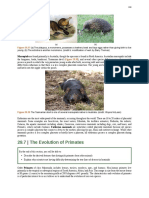0 ratings0% found this document useful (0 votes)
272 viewsEvolution
Evolution
Uploaded by
Aagash Pranav1. Evolution is the process by which living organisms evolve from earlier, simpler organisms through natural selection over time.
2. Early humans evolved from primate ancestors in Africa around 10-12 million years ago, with some lineages retaining their ancestral traits like living in trees, while the lineage leading to humans adapted to living and walking on land.
3. Fossils of early humans like Australopithecus provide evidence of the transition from ancestral primates to walking upright on two legs, though they retained some ape-like traits like smaller brains.
Copyright:
© All Rights Reserved
Available Formats
Download as DOCX, PDF, TXT or read online from Scribd
Evolution
Evolution
Uploaded by
Aagash Pranav0 ratings0% found this document useful (0 votes)
272 views16 pages1. Evolution is the process by which living organisms evolve from earlier, simpler organisms through natural selection over time.
2. Early humans evolved from primate ancestors in Africa around 10-12 million years ago, with some lineages retaining their ancestral traits like living in trees, while the lineage leading to humans adapted to living and walking on land.
3. Fossils of early humans like Australopithecus provide evidence of the transition from ancestral primates to walking upright on two legs, though they retained some ape-like traits like smaller brains.
Copyright
© © All Rights Reserved
Available Formats
DOCX, PDF, TXT or read online from Scribd
Share this document
Did you find this document useful?
Is this content inappropriate?
1. Evolution is the process by which living organisms evolve from earlier, simpler organisms through natural selection over time.
2. Early humans evolved from primate ancestors in Africa around 10-12 million years ago, with some lineages retaining their ancestral traits like living in trees, while the lineage leading to humans adapted to living and walking on land.
3. Fossils of early humans like Australopithecus provide evidence of the transition from ancestral primates to walking upright on two legs, though they retained some ape-like traits like smaller brains.
Copyright:
© All Rights Reserved
Available Formats
Download as DOCX, PDF, TXT or read online from Scribd
Download as docx, pdf, or txt
0 ratings0% found this document useful (0 votes)
272 views16 pagesEvolution
Evolution
Uploaded by
Aagash Pranav1. Evolution is the process by which living organisms evolve from earlier, simpler organisms through natural selection over time.
2. Early humans evolved from primate ancestors in Africa around 10-12 million years ago, with some lineages retaining their ancestral traits like living in trees, while the lineage leading to humans adapted to living and walking on land.
3. Fossils of early humans like Australopithecus provide evidence of the transition from ancestral primates to walking upright on two legs, though they retained some ape-like traits like smaller brains.
Copyright:
© All Rights Reserved
Available Formats
Download as DOCX, PDF, TXT or read online from Scribd
Download as docx, pdf, or txt
You are on page 1of 16
What Is Evolution?
Evolution is the process by which living organisms evolve
from earlier, more simple organisms. According to the
scientist Charles Darwin (1809–1882), evolution depends on
a process called natural selection. Natural selection results in
the increased reproductive capacities of organisms that are
best suited for the conditions in which they are living.
Darwin’s theory was that organisms evolve as a result of
many slight changes over the course of time. In this article,
we will discuss evolution during pre-human times and human
prehistory. During prehistory, writing was not yet developed.
But much important information on prehistory is obtained
through studies of the fossil record .
How Did Humans Evolve?
Primates, like humans, are mammals. Around ten to twelve
million years ago, the ancestral primate lineage split through
speciation The formation of new and distinct species in the
course of evolution. from one common ancestor into two
major groups. These two lineages evolved separately to
become the variety of species we see today. Members of one
group were the early version of what we know today as the
great apes (gorillas, chimpanzees, and bonobos in Africa,
orangutans in Asia) that is, the modern great apes evolved
from this ancestral group. They mostly remained in forest
with an arboreal lifestyle, meaning they live in trees. Great
apes are also quadrupeds which means they move around
with four legs on the ground. The other group evolved in a
different way. They became terrestrial, meaning they live on
land and not in trees. From being quadrupeds they evolved
to bipeds, meaning they move around on their two back legs.
In addition the size of their brain increased. This is the group
that, through evolution, gave rise to the modern current
humans. Many fossils found in Africa are from the genus
named Australopithecus (which means southern ape). This
genus is extinct, but fossil studies revealed interesting
features about their adaptation toward a terrestrial lifestyle.
Dryopithecus
Dryopithecus, genus of extinct ape that is representative of
early members of the lineage that includes humans and other
apes. Although Dryopithecus has been known by a variety of
names based upon fragmentary material found over a
widespread area including Europe, Africa, and Asia, it
appears probable that only a single genus is represented.
Dryopithecus is found as fossils in Miocene and Pliocene
deposits (23 to 2.6 million years old) and apparently
originated in Africa.
Several distinct forms of Dryopithecus are known, including
small, medium, and large, gorilla-sized animals. In many
ways, as might be expected, Dryopithecus is rather
generalized in structure and lacks most of the specializations
that distinguish living humans and other living apes. The
canine teeth are larger than those in humans but not as
strongly developed as those in other living apes. The limbs
were not excessively long. The skull lacked the well-
developed crests and massive brow ridges found in modern
apes.
Dryopithecus was a distant Miocene forerunner of gorillas
and chimpanzees. A form close to this branching of the
dryopithecine stock is represented by the genus
Ramapithecus, distinguished by its more advanced dentition.
The dryopithecines probably inhabited forested areas.
Ramapithecus
Ramapithecus, fossil primate dating from the Middle and
Late Miocene epochs (about 16.6 million to 5.3 million years
ago). For a time in the 1960s and ’70s, Ramapithecus was
thought to be a distinct genus that was the first direct
ancestor of modern humans (Homo sapiens) before it
became regarded as that of the orangutan ancestor
Sivapithecus.
The first Ramapithecus fossils (fragments of an upper jaw and
some teeth) were discovered in 1932 in fossil deposits in the
Siwālik hills of northern India. No significance was attached
to those fossils until 1960, when American anthropologist
Elwyn Simons of Yale University began studying them and fit
the jaw fragments together. On the basis of his observations
of the shape of the jaw and of the morphology of the teeth—
which he thought were transitional between those of apes
and humans—Simons advanced the theory that
Ramapithecus represented the first step in the evolutionary
divergence of humans from the common hominoid stock that
produced modern apes and humans.
Simons’s theory was strongly supported by his student
English-born American anthropologist David Pilbeam and
soon gained wide acceptance among anthropologists. The
age of the fossils (about 14 million years) fit well with the
then-prevailing notion that the ape-human split had occurred
at least 15 million years ago. The first challenge to the theory
came in the late 1960s from American biochemist Allan
Wilson and American anthropologist Vincent Sarich, who, at
the University of California, Berkeley, had been comparing
the molecular chemistry of albumins (blood proteins) among
various animal species. They concluded that the ape-human
divergence must have occurred much later than
Ramapithecus. (It is now thought that the final split took
place some 6 million to 8 million years ago.)
Wilson and Sarich’s argument was initially dismissed by
anthropologists, but biochemical and fossil evidence
mounted in favour of it. Finally, in 1976, Pilbeam discovered
a complete Ramapithecus jaw, not far from the initial fossil
find, that had a distinctive V shape and thus differed
markedly from the parabolic shape of the jaws of members
of the human lineage. He soon repudiated his belief in
Ramapithecus as a human ancestor, and the theory was
largely abandoned by the early 1980s. Ramapithecus fossils
subsequently were found to resemble those of the fossil
primate genus Sivapithecus, which is now regarded as
ancestral to the orangutan; the belief also grew that
Ramapithecus probably should be included in the
Sivapithecus genus.
Australopithecus, (Latin: “southern ape”) (genus
Australopithecus), group of extinct primates closely related
to, if not actually ancestors of, modern human beings and
known from a series of fossils found at numerous sites in
eastern, north-central, and southern Africa. The various
species of Australopithecus lived 4.4 million to 1.4 million
years ago (mya), during the Pliocene and Pleistocene epochs
(which lasted from 5.3 million to 11,700 years ago). The
genus name, meaning “southern ape,” refers to the first
fossils found, which were discovered in South Africa. Perhaps
the most famous specimen of Australopithecus is “Lucy,” a
remarkably preserved fossilized skeleton from Ethiopia that
has been dated to 3.2 mya.
As characterized by the fossil evidence, members of
Australopithecus bore a combination of humanlike and
apelike traits. They were similar to modern humans in that
they were bipedal (that is, they walked on two legs), but, like
apes, they had small brains. Their canine teeth were smaller
than those found in apes, and their cheek teeth were larger
than those of modern humans. The general term australopith
(or australopithecine) is used informally to refer to members
of the genus Australopithecus. Australopithecines include the
genus Paranthropus (2.3–1.2 mya), which comprises three
species of australopiths—collectively called the “robusts”
because of their very large cheek teeth set in massive jaws.
Non-australopithecine members of the human lineage
(hominins) include Sahelanthropus tchadensis (7–6 mya),
Orrorin tugenensis (6 mya), Ardipithecus kadabba (5.8–5.2
mya), and Ar. ramidus (5.8–4.4 mya)—that is, pre-
Australopithecus species that are considered to be ancient
humans—and one additional species of early human,
Kenyanthropus platyops (3.5 mya). The first undisputed
evidence of the genus Homo—the genus that includes
modern human beings—appears as early as 2.8 mya, and
some of the characteristics of Homo resemble those of
earlier species of Australopithecus; however, considerable
debate surrounds the identity of the earliest species of
Homo. In contrast, remains older than six million years are
widely regarded to be those of fossil apes
Homo erectus, (Latin: “upright man”) extinct species of the
human genus (Homo), perhaps an ancestor of modern
humans (Homo sapiens). H. erectus most likely originated in
Africa, though Eurasia cannot be ruled out. Regardless of
where it first evolved, the species seems to have dispersed
quickly, starting about 1.9 million years ago (mya) near the
middle of the Pleistocene Epoch, moving through the African
tropics, Europe, South Asia, and Southeast Asia. This history
has been recorded directly if imprecisely by many sites that
have yielded fossil remains of H. erectus. At other localities,
broken animal bones and stone tools have indicated the
presence of the species, though there are no traces of the
people themselves. H. erectus was a human of medium
stature that walked upright. The braincase was low, the
forehead was receded, and the nose, jaws, and palate were
wide. The brain was smaller and the teeth larger than in
modern humans. H. erectus appears to have been the first
human species to control fire, some 1,000,000 years ago. The
species seems to have flourished until some 200,000 years
ago (200 kya) or perhaps later before giving way to other
humans including Homo sapiens.
Fossil evidence
The earliest finds
The first fossils attributed to Homo erectus were discovered
by a Dutch army surgeon, Eugène Dubois, who began his
search for ancient human bones on the island of Java (now
part of Indonesia) in 1890. Dubois found his first specimen in
the same year, and in 1891 a well-preserved skullcap was
unearthed at Trinil on the Solo River. Considering its
prominent browridges, retreating forehead, and angled rear
skull, Dubois concluded that the Trinil cranium showed
anatomic features intermediate between those of humans
(as they were then understood) and those of apes. Several
years later, near where the skull was discovered, he found a
remarkably complete and modern-looking femur
(thighbone). Since this bone was so similar to a modern
human femur, Dubois decided that the individual to which it
belonged must have walked erect. He adopted the name
Pithecanthropus (coined earlier by the German zoologist
Ernst Haeckel) and called his discoveries Pithecanthropus
erectus (“upright ape-man”), but the colloquial term became
“Java man.” Only a few other limb fragments turned up in the
Trinil excavations, and it would be some three decades
before more substantial evidence appeared. Most
paleontologists now regard all of this material as H. erectus,
and the name Pithecanthropus has been dropped.
Homo sapiens, (Latin: “wise man”) the species to which all
modern human beings belong. Homo sapiens is one of
several species grouped into the genus Homo, but it is the
only one that is not extinct. See also human evolution.
The name Homo sapiens was applied in 1758 by the father of
modern biological classification (see taxonomy), Carolus
Linnaeus. It had long been known that human beings
physically resemble the primates more closely than any other
known living organisms, but at the time it was a daring act to
classify human beings within the same framework used for
the rest of nature. Linnaeus, concerned exclusively with
similarities in bodily structure, faced only the problem of
distinguishing H. sapiens from apes (gorillas, chimpanzees,
orangutans, and gibbons), which differ from humans in
numerous bodily as well as cognitive features. (Charles
Darwin’s treatise on evolution, On the Origin of Species,
would come 101 years later.)
Since Linnaeus’s time, a large fossil record has been
discovered. This record contains numerous extinct species
that are much more closely related to humans than to
today’s apes and that were presumably more similar to H.
sapiens behaviorally as well. Following the ancestors of
modern human beings into the distant past raises the
question of what is meant by the word human. H. sapiens is
human by definition, whereas apes are not. But what of the
extinct members of the human tribe (Hominini), who were
clearly not H. sapiens but were nonetheless very much like
them? There is no definitive answer to this question.
Although human evolution can be said to involve all those
species more closely related to H. sapiens than to the apes,
the adjective human is usually applied only to H. sapiens and
other members of the genus Homo (e.g., H. erectus, H.
habilis). Behaviorally, only H. sapiens can be said to be “fully
human,” but even the definition of H. sapiens is a matter of
active debate. Some paleoanthropologists extend the span of
this species far back into time to include many anatomically
distinctive fossils that others prefer to allocate to several
different extinct species. In contrast, a majority of
paleoanthropologists, wishing to bring the study of hominins
into line with that of other mammals, prefer to assign to H.
sapiens only those fossil forms that fall within the anatomic
spectrum of the species as it exists today. In this sense, H.
sapiens is very recent, having originated in Africa more than
315,000 years ago (315 kya).
You might also like
- Human Evolution ZOOLOGY PROJECTDocument11 pagesHuman Evolution ZOOLOGY PROJECTpravenkumar100% (4)
- Project of Environmental StudiesDocument29 pagesProject of Environmental StudiesAtish Nilakhe100% (1)
- Homo HabilisDocument3 pagesHomo HabilisGlutton Arch100% (1)
- Human EvolutionDocument9 pagesHuman EvolutionVinod BhaskarNo ratings yet
- Human EvolutionDocument23 pagesHuman EvolutionArpit Shukla75% (4)
- Human Evolution: Mr. H. JonesDocument23 pagesHuman Evolution: Mr. H. Jonessccscience100% (1)
- P-27 Human EvolutionDocument8 pagesP-27 Human EvolutionFelix Joshua.B 10 B100% (1)
- Human EvolutionDocument21 pagesHuman Evolutionhirithikd01No ratings yet
- Apex ProjectDocument12 pagesApex ProjectGajendra YadavNo ratings yet
- Biology Project HUMAN EVOLUTIONDocument12 pagesBiology Project HUMAN EVOLUTIONanonymous user 345No ratings yet
- Genetic DisordersDocument58 pagesGenetic DisordersAce Lalicon100% (1)
- Biology Investigatory ProjectDocument6 pagesBiology Investigatory ProjectHiromi Minatozaki33% (3)
- Raj R 12 Bio InvestigatoryDocument16 pagesRaj R 12 Bio InvestigatorySANJAY PARMARNo ratings yet
- Science ProjectDocument16 pagesScience Projectapi-3731257No ratings yet
- Project Work: InvestigatoryDocument16 pagesProject Work: InvestigatoryRahul DasNo ratings yet
- Different Homo SpeciesDocument25 pagesDifferent Homo SpeciesRiddhi BhattacharyaNo ratings yet
- English ProjectDocument31 pagesEnglish ProjectTurgid gamingNo ratings yet
- Human EvolutionDocument6 pagesHuman EvolutionblahNo ratings yet
- Biology Investigatory ProjectDocument20 pagesBiology Investigatory ProjectAnsia Meenaz100% (1)
- Biology Investigatory ProjectDocument26 pagesBiology Investigatory ProjectParvez hassan88% (111)
- Pedigree AnalysisrrrrrDocument16 pagesPedigree AnalysisrrrrrFraizner FenilNo ratings yet
- CBSE Class 12 Biology - Biodiversity and Conservation AssignmentDocument8 pagesCBSE Class 12 Biology - Biodiversity and Conservation AssignmentPiyush VermaNo ratings yet
- Abishek S English Project 23 - 24 FinalDocument23 pagesAbishek S English Project 23 - 24 FinalPhoenix ParkerNo ratings yet
- Human Genome Project Class 12Document7 pagesHuman Genome Project Class 12davidkumar54dk100% (1)
- CBSE Sample Question Paper 2022 2023 Class 12 English SolvedDocument26 pagesCBSE Sample Question Paper 2022 2023 Class 12 English SolvedRaghav NaagarNo ratings yet
- Bio Investigation ProjectDocument19 pagesBio Investigation ProjectMr StarkNo ratings yet
- Biology ProjectDocument14 pagesBiology Projectflora100% (1)
- Biology Class 12 ProjectDocument17 pagesBiology Class 12 ProjectSouranshu BiswasNo ratings yet
- Human Cloning - Another YouDocument17 pagesHuman Cloning - Another Youpratyushkarn100% (1)
- Shree Swaminarayan Public School Gandhinagar: Biology Investigatory Project On Life Cycle of Butterfly 2020-21 (CLASS-XI)Document3 pagesShree Swaminarayan Public School Gandhinagar: Biology Investigatory Project On Life Cycle of Butterfly 2020-21 (CLASS-XI)Yash Raval100% (1)
- English InvestigatoryDocument24 pagesEnglish InvestigatoryRakshith RajaramNo ratings yet
- VSPK International School: Biology Investigatory ProjectDocument25 pagesVSPK International School: Biology Investigatory ProjectPalakNo ratings yet
- Biology ProjectDocument52 pagesBiology ProjectBhagat Bhandari67% (3)
- Biology Project Pedigree Analysis Class 12Document21 pagesBiology Project Pedigree Analysis Class 12Anonymous DWvfJuMcQNo ratings yet
- Bio Project File 2Document19 pagesBio Project File 2jiya singhNo ratings yet
- Bio Project RDocument20 pagesBio Project RSanjukth100% (1)
- Study of Cancer Investigatory ProjectDocument15 pagesStudy of Cancer Investigatory ProjectsaralaNo ratings yet
- IntroductionDocument21 pagesIntroductionsachinagsNo ratings yet
- Biology Project: Five Kingdom ClassificationDocument10 pagesBiology Project: Five Kingdom ClassificationKINSHUK SINGHNo ratings yet
- Human DiseaseDocument13 pagesHuman DiseaseAvnish BhasinNo ratings yet
- Saurav Biology Class 11Document21 pagesSaurav Biology Class 11Sanjay KumarNo ratings yet
- EnergyDocument6 pagesEnergyChristina LuluquisinNo ratings yet
- Dispersal - of - Seeds - by - Various - Agencies (Mohan) FinalDocument21 pagesDispersal - of - Seeds - by - Various - Agencies (Mohan) FinalKishore Notty100% (2)
- Biology Investigatory ProjectDocument15 pagesBiology Investigatory Projectvarunkaran13100% (1)
- Karan ProjectDocument12 pagesKaran ProjectAnshika SinghNo ratings yet
- Project Report On Human DiseasesDocument17 pagesProject Report On Human DiseasesNaven BansalNo ratings yet
- Investigatory Project Biology: Lanva-PatanDocument28 pagesInvestigatory Project Biology: Lanva-PatanSANJAY PARMAR100% (1)
- Organism and Population - CBSE Biology Class XII Notes - Cbsebiology4u PDFDocument14 pagesOrganism and Population - CBSE Biology Class XII Notes - Cbsebiology4u PDFabhiNo ratings yet
- Birth Control ProjectDocument16 pagesBirth Control ProjectTishana Thompson100% (1)
- Human Diseases - Class 11 Biology ProjectDocument13 pagesHuman Diseases - Class 11 Biology ProjectShahanawaz Khan100% (2)
- Reproductive HealthDocument16 pagesReproductive HealthShazia Khatoon100% (1)
- Biology Investigatory ProjectDocument44 pagesBiology Investigatory ProjectVaishnavi AvisagaddaNo ratings yet
- Human 20evolutionDocument17 pagesHuman 20evolutionArchit GulkariNo ratings yet
- Biology Ebola Virus Project ReportDocument19 pagesBiology Ebola Virus Project ReportChaitaneyMorNo ratings yet
- Tracing Back The Human Bio-Cultural and Social EvolutionDocument32 pagesTracing Back The Human Bio-Cultural and Social EvolutionThedz AlarteNo ratings yet
- Infos Ape To ManDocument8 pagesInfos Ape To Manjosh salahidNo ratings yet
- Written Report For Ucsp: Biological and Cultural Evolution: From Australopithecus To Homo SapiensDocument10 pagesWritten Report For Ucsp: Biological and Cultural Evolution: From Australopithecus To Homo SapiensJustin Raton ManingoNo ratings yet
- Human EvoDocument13 pagesHuman EvomahinnilavanNo ratings yet
- Evolution of MankindDocument8 pagesEvolution of MankindPrecious Renzlyn CadionNo ratings yet
- Evolution of ManDocument10 pagesEvolution of Manarpanrin2No ratings yet
- Biological and Cultural Evolution by Jeff 103612Document63 pagesBiological and Cultural Evolution by Jeff 103612ClaiireNo ratings yet
- Different Stages of Human EvolutionDocument2 pagesDifferent Stages of Human EvolutionMAREEZ E ISHQ MAREEZ E ISHQNo ratings yet
- Homo LuzonensisDocument3 pagesHomo LuzonensisJepney ArellanoNo ratings yet
- Homo - Habilis.Ar1fact.1. Homo - Habilis.Ar1fact.2.: Arch - Support!Document3 pagesHomo - Habilis.Ar1fact.1. Homo - Habilis.Ar1fact.2.: Arch - Support!OliviaNo ratings yet
- 26 3 PowerPointDocument23 pages26 3 PowerPointManojit BhattacharyaNo ratings yet
- Human Evolution - Simple English Wikipedia, The Free EncyclopediaDocument63 pagesHuman Evolution - Simple English Wikipedia, The Free Encyclopediasupriyavarma252009No ratings yet
- Originea Si Evolutia Omului Varianta FinalaDocument1 pageOriginea Si Evolutia Omului Varianta FinalaRoberta NicolaNo ratings yet
- Different Stages of Human Evolution and Their Major Characteristics PDFDocument2 pagesDifferent Stages of Human Evolution and Their Major Characteristics PDFStudy in an easy wayNo ratings yet
- 2015 Papagianni, Dimitra & Morse, Michael Aris Poulianos & The Petralona AffaírDocument6 pages2015 Papagianni, Dimitra & Morse, Michael Aris Poulianos & The Petralona AffaírPelasgosNo ratings yet
- UCSP Chapter 3Document32 pagesUCSP Chapter 3Condring ConcisoNo ratings yet
- 1.1 Human Origins in AfricaDocument20 pages1.1 Human Origins in Africa재인최No ratings yet
- 1 Gum:Uhab Ílis: Homohabilis Subsaharan Olduvaigorge TanzaniaDocument13 pages1 Gum:Uhab Ílis: Homohabilis Subsaharan Olduvaigorge TanzaniaSophan PhorkNo ratings yet
- Analisis Butir SoalDocument32 pagesAnalisis Butir Soalrisah elisaNo ratings yet
- Prehistoric Era (Until C. 3300 BCE) : PaleolithicDocument2 pagesPrehistoric Era (Until C. 3300 BCE) : PaleolithicRajashekar PrasadNo ratings yet
- Early Modern Human: Name and TaxonomyDocument29 pagesEarly Modern Human: Name and TaxonomySebastian GhermanNo ratings yet
- Ucsp 11 Q1 M10Document16 pagesUcsp 11 Q1 M10GeeanneNo ratings yet
- Summative Mod3 UcspDocument2 pagesSummative Mod3 UcspKATHRINA SUNGANo ratings yet
- Biological and Cultural EvolutionDocument5 pagesBiological and Cultural EvolutionMark Christian AlmazamNo ratings yet
- Hominids: Millania Putri Shayen 1810422034Document13 pagesHominids: Millania Putri Shayen 1810422034Millania Putri ShayenNo ratings yet
- Olduwan Culture and Osteodontokeratic CultureDocument2 pagesOlduwan Culture and Osteodontokeratic Cultureanu ruhan505No ratings yet
- The Story of Human Evolution 8thsDocument2 pagesThe Story of Human Evolution 8thsRosibel YgNo ratings yet
- Human Evolution: Full ImageDocument2 pagesHuman Evolution: Full Imagenikita bajpaiNo ratings yet
- Reading13 PDFDocument8 pagesReading13 PDFklavier10244379No ratings yet
- Program Dinasan 1-30 April 2024Document25 pagesProgram Dinasan 1-30 April 2024ariannyeunikeNo ratings yet
- Ejercicio CD Frabica Y Lugar de VentaDocument3 pagesEjercicio CD Frabica Y Lugar de VentaJUAN DIEGO GUILLEN CORDERONo ratings yet
- My Own Theory of Devolution Jessica Zafra: Hennsy Q. Del Rosario 16-11205 Bsed-Filipino 4/4/20Document2 pagesMy Own Theory of Devolution Jessica Zafra: Hennsy Q. Del Rosario 16-11205 Bsed-Filipino 4/4/20caryl mollanedaNo ratings yet
- Human-Migration-Patterns Teacher PDF VersionDocument5 pagesHuman-Migration-Patterns Teacher PDF VersionjadelineNo ratings yet
- Phylogenetic Relations and Geographic Distribution of I-L38 (Aka I2b2)Document16 pagesPhylogenetic Relations and Geographic Distribution of I-L38 (Aka I2b2)pcanongesNo ratings yet
- 2.pre History of TelanganaDocument40 pages2.pre History of TelanganaSunil SamratNo ratings yet
- OppenheimerDocument15 pagesOppenheimermilica cucuzNo ratings yet

























































































